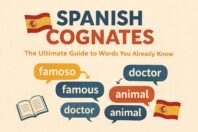Comer vs Comerse: Telling these two verbs apart

Get our free email course, Shortcut to Conversational.
Have conversations faster, understand people when they speak fast, and other tested tips to learn faster.
More infoWe know that some Spanish verbs can seem tricky, especially when they look similar. When it comes to understanding the difference between comer vs comerse, however, we can assure you that it’s a piece of cake. By the end of this post, you’ll surely master the differences between Spanish comer and comerse!
Comer means to eat in Spanish, and it’s a basic verb that you will encounter early on in your Spanish journey. In spoken Spanish, however, it’s also quite common to hear the pronominal form comerse, which also means to eat.
So how does it really work? Is comer a reflexive verb? Spoiler alert: no. But we’ll get to this soon enough
Spanish ingestion verbs
Before we focus on comer vs comerse, we need to introduce a special category of Spanish verbs known as the ingestion verbs. These verbs are comer, beber, tomar, and fumar.
These Spanish ingestion verbs all have a pronominal form where we see the -se added to the end, and they all behave exactly like comer and comerse. We’ll be talking about comer vs comerse today because it’s the most common instance of this particular use of se.
Now, let’s take a look at each verb. Like we said above, comer means ‘to eat’ in Spanish. It is a regular -er verb, and its conjugation follows the typical patterns for verbs ending in -er. It’s also a transitive verb, meaning that it needs to take a direct object.
- No me gusta comer dulces antes del almuerzo. – I don’t like to eat sweets before lunch.
- Ella quiere comer macarrones con queso. – She wants to eat macaroni and cheese.
- Si como camarones, me pongo muy mal. Soy alérgico. – If I eat shrimp, I get very sick. I’m allergic.
Now, comerse is a pronominal use of comer. Even though it has se in it and the pronoun has to agree with the subject, it’s not a reflexive verb since the subject and object are different. In fact, comerse, just like comer, needs a direct object. Let’s take a look!
- Ayer me comí un emparedado de queso. – Yesterday I ate a cheese sandwich.
- Él se come todo lo que hay en el plato. – He eats everything on the plate.
- ¿Ustedes se comieron mi pastel de queso? – Did you eat my cheesecake?
- Cada uno se comió tres empanadas. – We each ate three empanadas.
- Mis hermanos se comieron una bandeja de galletas. – My brothers ate a tray of cookies.
Comer vs Comerse: specific quantities
The key difference between these two verbs is that comerse implies completion, meaning that whatever is being eaten is consumed in its entirety. Because of this, the direct object always comes in a specific quantity or preceded by a determiner or adverbial phrases that indicate totality. In these cases, when the quantity of the object is specified, comerse is favored in spoken Spanish to the point where trading it for comer may sound incorrect to a native, even when it’s still grammatically correct. If the quantity is not specified, then comerse can’t be used in the sentence.
- Ella se comió el pollo. – She ate the chicken.
- Él se comió toda la tortilla. – He ate all the tortilla.
- ¡Tú te comiste dos mangos. – You ate two mangoes.
- No me comí tus tacos. – I didn’t eat your tacos.
In these sentences, the use of comerse is possible because the direct object is quantified, and while it’s not mandatory, keep in mind that comerse is preferred in these instances.
In contrast, we can only use comer when the amount of food consumed is not specified, meaning that we don’t know if it was eaten in its entirety or not. Because of this, phrases that indicate indefinite amounts can only be used with comer.
- Estoy comiendo pizza con champiñones. – I’m eating pizza with mushrooms.
- Ayer comí algo del pastel que trajiste. Estaba delicioso. – Yesterday I ate some of the pie you brought. It was delicious.
- Comí muchos dulces y me duele el estómago. – I ate a lot of sweets and my stomach hurts.
- Voy a comer un poco de pollo para acompañar el arroz. – I’m going to eat some chicken to go with the rice.
- Mejor comamos ensalada, estamos intentando comer sano este año. – Let’s have some salad instead, we are trying to eat healthy this year.
Comer vs Comerse: general sense
When talking about eating in a generic way, such as talking about eating habits or food preferences, comer is the only possible option. Notice that in this case it’s possible to omit the direct object when we’re focusing on how the subject is eating instead of what.
- Me gusta comer manzanas acarameladas. – I like to eat caramel apples.
- No como lácteos, me hacen daño. – I don’t eat dairy, it’s bad for me.
- Él come muy rápido. – He eats very fast.
- Ellos comen aunque no tengan hambre. – They eat even if they’re not hungry.
Comer vs comerse: adverbials of time
Due to the specificity involved, certain time adverbials can be compatible with both comer and comerse, or exclusively with comer. When the expression delineates a time frame without a distinct conclusion, it is suitable only for use with comer. Conversely, if the expression specifies a definite ending, it can be employed with both comer and comerse. Expressions featuring durante or por are not suitable for use with comerse, as they suggest a prolonged duration of time with no apparent conclusion to the action.
- Ella comió durante dos horas porque se distraía con la televisión. – She ate for two hours because she was distracted by the television.
- Comieron por poco tiempo ya que debían volver a trabajar. – They ate for a short time because they had to go back to work.
- Mi esposo se comió tres mandarinas en diez minutos. – My husband ate three tangerines in ten minutes.
- Mi papá se come una hamburguesa entera en segundos. – My dad eats a whole hamburger in seconds.
Conclusion: Comer vs Comerse
That’s it! Now let’s do a quick recap to make sure everything is clear!
While both verbs share the commonality of conveying the act of eating, their nuanced differences become evident in specific contexts. Comer serves as the general term for eating, applicable when discussing generic eating habits, food preferences, or consuming unspecified amounts. On the other hand, comerse implies completion, signifying the consumption of an entire quantity. This distinction becomes particularly pronounced when the direct object is quantified, and expressions conveying totality are employed.
Moreover, when incorporating adverbials of time, it’s crucial to recognize the specificities involved. Time frames without a clear ending align with comer, whereas those with a delimited conclusion can accommodate both comer and comerse. Notably, expressions featuring “durante” or “por” are exclusive to comer, as they imply an extended duration rather than endpoint to the eating action.
By grasping these subtleties, you enhance your ability to communicate with accuracy, ensuring that your choice between comer and comerse seamlessly aligns with the intended meaning, ultimately showcasing your command of the Spanish language.
Comer vs Comerse: Exercises
Now that you know all the theory, it’s time to put what you’ve learned into practice. Read carefully, pay attention to the context, determiners and adverbials used, and choose the right option that best suits the sentence.
1. ¿De verdad _____ todos los bocadillos, Emilio? ¡Eran para la fiesta de esta noche!
a) te comiste
b) come
c) como
2. Ustedes _____ muy pocos vegetales, necesitan comer más.
a) comemos
b) comen
c) se comen
3. Ayer _____ tres pizzas yo solo.
a) nos comimos
b) me comí
c) comimos
4. Te sientes mal porque _____ muy rápido.
a) comes
b) te comes
c) comían
5. No creo que Luis tenga hambre. Nosotros _____ un poco de pavo antes de venir.
a) nos comamos
b) nos comimos
c) comimos
6. Es increíble, pero los niños _____ todos los chocolates en un parpadeo.
a) comerse
b) comían
c) se comieron
7. No exageres, solo _____ un pedazo de tarta. Te dejé suficiente.
a) comeríamos
b) me comí
c) comieron
8. Tu hermana _____ mucho helado, por eso tiene caries.
a) comen
b) se come
c) come
9. Ayer ustedes _____ todas las galletas en menos de una hora.
a) nos comimos
b) se comieron
c) comerán
10. Siempre _____ sopa de tomate cuando estoy enfermo.
a) me como
b) comemos
c) como
Answers
1. ¿De verdad te comiste todos los bocadillos, Emilio? ¡Eran para la fiesta de esta noche! – Did you really eat all the snacks, Emilio? They were for tonight’s party!
a) te comiste
2. Ustedes comen muy pocos vegetales, necesitan comer más. – You eat very few vegetables, you need to eat more.
b) comen
3. Ayer me comí tres pizzas yo solo. – I ate three pizzas by myself yesterday.
b) me comí
4. Te sientes mal del estómago porque comes muy rápido. – Your stomach is upset because you eat too fast.
a) comes
5. No creo que Luis tenga hambre. Nosotros comimos un poco de pavo antes de venir. – I don’t think Luis is hungry. We ate some turkey before we came over.
c) comimos
6. Es increíble, pero los niños se comieron todos los chocolates en un parpadeo. – It’s unbelievable, but the children ate all the chocolates in the blink of an eye.
c) se comieron
7. No exageres, solo me comí un pedazo de tarta. Te dejé suficiente. – Don’t exaggerate, I only ate one piece of pie. I left you enough.
b) me comí
8. Tu hermana come mucho helado, por eso tiene caries. – Your sister eats a lot of ice cream, that’s why she has cavities.
c) come
9. Ayer ustedes se comieron todas las galletas en menos de una hora. – Yesterday you guys ate all the cookies in less than an hour.
b) se comieron
10. Siempre como sopa de tomate cuando estoy enfermo. – I always eat tomato soup when I am sick.
c) como



